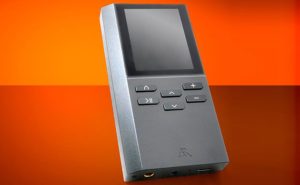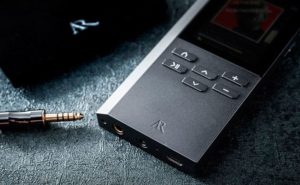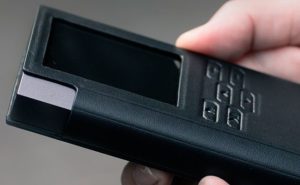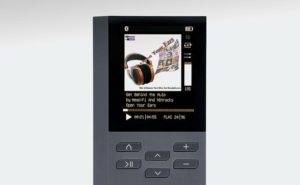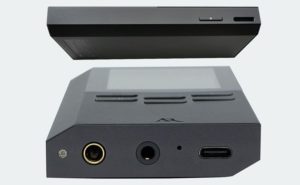DAP Acoustic Research offers brawny and energetic bass, musical and smooth midrange as well as free, transparent high notes.
At the beginning of this year in the “internet” appeared information about launching a portable player of the Acoustic Research AR-M200. An American company with decades of experience probably associates every self-respecting audiophile. It is true that the AR department dealing with portable devices (apart from DAPs are headphones and accessories) is relatively young, but noblesse oblige, so the opportunity to test the new DAP from this stable I was very pleased.
Encouraged by opinions on the topic of Acoustic Research portable musicians, I decided to take a look at the current offer of the producer. Three “HIFI Media Players” (the term comes from the AR site) is a very modest offer, not to say poor, especially when compared to the offer of Far East brands growing like mushrooms after the rain, which such machines get in a dozen or so paces more, but – as wise people say – sometimes less is more. Especially since the mobile portfolio of Acoustic Research is well thought out and logically organized.
At the highest level among DAPs is currently AR-M2 operating on the basis of Android and DAC Burr-Brown PCM1794A. The lower level is occupied by the AR-M20, also with Android on board and Burr-Brown, but now PCM5242. In turn, the AR-M200 described here is – judging from the seemingly simple – a real minimalist. Without a green robot, a touch screen and lots of fancy functions. So what, without a revelation? Well, not necessarily. After all, they teach in kindergarten that everything is not golden what is shining.
Construction and functionality
AR-M200 was intended to be the manufacturer of DAP, above all simple to use and functional. Deprived of goodies in the form of a touch screen with UHD resolution that draws the current like horse drops. It turned out that all you need is a 2.4-inch 240×320 “chapter”. OK, the interface is a bit clumsy by all these cuts, six buttons (home, enter / play / pause, up and down arrows, “+” and “-” for volume control) are not very intuitive (there is no shortage of space under the display, so they could easily create a circle, for example), and searching resources could be faster.
“The sound of DAP Acoustic Research is free from artificiality related to data reconstruction, filtering, or God knows what other binary effects on the audio signal”
But there are also surprises. And what! Above all – finally! – a type C USB socket instead of a hopeless micro-USB, which hardly ever gets hit the first time. For this balanced 4.4mm headphone jack (relatively new Sony Pentaconn standard) next to, of course, the classic mini 3.5mm. We also have to enjoy perfect integration with the computer, thanks to which, after connecting the DAP to a PC, the library can be operated eg from Total Commander level, which is very convenient.
The AR-M200 ergonomics is not too bad either. The player is surely in your hand, it is pleasant to touch and light. This last feature results from the use of plastic, which (on the front and sides) looks like metal. In turn, the backs have a “non-slip” texture that mimics the skin. What is most important from the point of view of a lover of high quality sound is not visible to the naked eye anyway. Investors were not invested in the tinsel, but in truly audiophile components, which – anticipating the continuation of the review – definitely paid off. First of all, a great DAC – AK4490EQ was used, thanks to which the AR-M200 natively supports 24/192 files as well as DSD up to 128 (5.6MHz) in DoP mode. In addition, Texas Instruments TPA 6120 operational amplifiers were thrown in, Burr-Brown OPA 2134 preamplifier and digital potentiometer with half-step step (150 steps). The 1700mAh battery allows the DAP AR to work for over 7 hours, despite the use of a headphone amplifier in class A. As the manufacturer emphasizes, this combination – A class amplifier (2Vrms), capacious battery and high-class components – allows the M200 to drive virtually any headphones and intrathecal headphones. The internal capacity is modest 32GB (28.6GB), but the memory card slot allows it to multiply. Positive tests have passed the “flash” SDXC up to 256GB. One should only remember that this type of media with a capacity of 64GB and higher, where the exFAT system is used, before inserting into the AR-M200, format it to the FAT32 system. The 1700mAh battery allows the DAP AR to work for over 7 hours, despite the use of a headphone amplifier in class A. As the manufacturer emphasizes, this combination – A class amplifier (2Vrms), capacious battery and high-class components – allows the M200 to drive virtually any headphones and intrathecal headphones. The internal capacity is modest 32GB (28.6GB), but the memory card slot allows it to multiply. Positive tests have passed the “flash” SDXC up to 256GB. One should only remember that this type of media with a capacity of 64GB and higher, where the exFAT system is used, before inserting into the AR-M200, format it to the FAT32 system. The 1700mAh battery allows the DAP AR to work for over 7 hours, despite the use of a headphone amplifier in class A. As the manufacturer emphasizes, this combination – A class amplifier (2Vrms), capacious battery and high-class components – allows the M200 to drive virtually any headphones and intrathecal headphones. The internal capacity is modest 32GB (28.6GB), but the memory card slot allows it to multiply. Positive tests have passed the “flash” SDXC up to 256GB. One should only remember that this type of media with a capacity of 64GB and higher, where the exFAT system is used, before inserting into the AR-M200, format it to the FAT32 system. capacitive battery and high-class components – allows the M200 to drive virtually any headphones and intrinsic headphones. The internal capacity is modest 32GB (28.6GB), but the memory card slot allows it to multiply. Positive tests have passed the “flash” SDXC up to 256GB. One should only remember that this type of media with a capacity of 64GB and higher, where the exFAT system is used, before inserting into the AR-M200, format it to the FAT32 system. capacitive battery and high-class components – allows the M200 to drive virtually any headphones and intrinsic headphones. The internal capacity is modest 32GB (28.6GB), but the memory card slot allows it to multiply. Positive tests have passed the “flash” SDXC up to 256GB. One should only remember that this type of media with a capacity of 64GB and higher, where the exFAT system is used, before inserting into the AR-M200, format it to the FAT32 system.
Let’s go back to functionality for a moment. It is true that there is no Wi-Fi and Tidal service, but there is a Bluetooth module with the support of the aptX codec and – tadam! – two-way communication, thanks to which DAP Acoustic Research can receive audio signal from other transmitters, eg a computer, tablet or smartphone, and then send it to connected headphones or, better yet, an amplifier (in the latter case you will need a minijack cable for 2x chinch ). Of course, the AR-M200 can also perform the classic function of an audio signal transmitter for headphones equipped with a Bluetooth receiver (in Music Mode select Music Settings, then Bluetooth Output and Scan – this is not so obvious, and the quick guide only tells you how configure M200 as Bluetooth Audio Reciver).
I mentioned the lack of goodies, right? It turns out that this is not exactly the case, because the AR-M200 has a built-in microphone (it is placed on the bottom, next to the sockets). It is useful when you set up the device as Bluetooth Audio Reciver and pair with your smartphone. Incoming calls can then be answered / rejected either on the phone or just on M200 (an appropriate message will be displayed on the DAP screen). It is true that I do not fully understand why someone would complicate their life so much, but I assume that in some situations (such as a temporary phone call) this may make sense.
Sound quality
It may sound like a truism, but the AR-M200 is very close to the music. First of all, its sound does not bear the typical signs of “digitization” – it is free of sharpness, dryness or sterility. Focusing on the sounds of instruments is child’s play, the brain does not have to perform additional operations. In other words, the sound of DAP Acoustic Research is free from the artificiality associated with data reconstruction, filtering whether God knows what else zeriekdynkowym operations on the audio signal. Concentrating on music and experiencing emotions is something obvious in this situation, because nothing in this message needs to be “interpolated”.
The strength of the AR-M200 is the reproduction of the lowest components. The bass is brawny, energetic, juicy and musical. The double bass is stable, has slightly rounded, though clearly outlined contours that do not soften and blur. The speed, coherence and selectivity of the low components is at a very decent level, as is the ability to express rhythmic accents. The bass guitar in Steven Wilson’s “Luminol” (FLAC 24/96) on the DAP AR gained – in comparison with the AK70 MKII described on the neighboring pages – a slightly warmer color and better spatiality. The player Astell & Kern presented, in turn, a slightly better attack elasticity, accuracy and greater dynamics, and provided information about the articulation with almost surgical precision. AR-M200 is not that uncompromising in this respect,
The range of the diameter seems – in comparison with the AK70 MKII – a bit more matte, but also more musical, more pleasant to receive. It does not prick or irritate, sibilants and micro-details are present, but do not bore into the skull, the message is a bit smoother. I really liked both the sound of the acoustic guitar (“The Watchmaker” from the album “The Raven …” by Steven Wilson) – energetic and clear, out of focus, but spontaneously reflecting the transient sounds, with clear details with a stronger attack and exemplary selectivity – and vocals – vivid, close and well saturated, sometimes accentuating hissing sounds (eg Norah Jones “Come Away With Me”), but not enough to talk about “programmatic” displaying of sibilants or a characteristic component of color.
The mountain is characterized by a fairly bright color, but in comparison with the AK70 MKII, it still gives the impression of being calm, i.e. less analytical, devoid of “bile”. It can not break records in terms of openness, but it carries a lot of energy, is free and clear enough to attract attention. The percussion plates are saturated, they last long and present a wide dynamic range. They are also very true, as shown by listening to the perfectly realized “Now This” album by Gary Peacock Trio (FLAC 24/96). With the ATH-AR5BT Audio Tech headphones, hi-hat sounded great – the contact of the upper sheet with the bottom gave a very authentic effect – point, short, well-defined and quickly fading “Cycle”.
The space created by the AR-M200 is characterized not so much by a precise location as by a large scale, spaciousness and density. The apparent sources are tangible, which results from the approximate scene. Both in smaller recordings (Norah Jones) and in larger instruments (eg Dead Can Dance “Amnesia”), the first plan dominates in the transmission, the impression of closeness is strong and clear. Slightly less convincing results spatial effects on further plans, although this aspect is largely dependent on the headphones connected to the DAP.
Summary
With something like this in your pocket (and on the headphones), you do not think about snapping your fingers on the screen and watching covers in super and ultra resolution. Consent, the AR-M200 interface could be more friendly, but this is not the most important thing. The sound of this DAP “goes” one time, comprehensively, smoothly and without any “buts”. For something like that, it’s worth taking up the challenge and becoming even … a minimalist.
Verdict: Acoustic Research AR-M200
-
Sound quality
★★★★★
-
Quality / Price
★★★★★
-
Execution
★★★★★
-
Capabilities
★★★★
Pros: Workmanship and ergonomics. USB-C and Bluetooth connection “both-way”! Saturated, musical and at the same time detailed sound
Cons: People accustomed to the UI (user interface) of such DAPs as the AK70 or XDP-300R may feel slightly confused
Total: Without “trinkets”, but with generous compensation in the form of a pure audiophile sound
Overall rating:
- PRODUCT
- Acoustic Research AR-M200
- TYPE
- Portable hi-res file player
- PRICE
- PLN 1,799
- WEIGHT
- 126 g
- DIMENSIONS (WxHxD)
- 58x119x15 mm
- THE MOST IMPORTANT FEATURES
-
- Headphone Amplifier in Class A (2Vrms)
- DAC: AKM AK4490EQ
- Supports audio formats: FLAC, ALAC and WAV up to 24 / 192kHz; DSD64 and DSD128
- Bluetooth: aptX, transmitter and receiver
- Display: 2.4 inches, 240×320 IPS LCD
- Internal capacity: 32GB
- 1x micro-SD card slot (up to 256GB)
- Battery: 1.700mAh
- Sockets: 3.5mm (unbalanced); 4.4mm (balanced); USB-C (battery charging and data transfer)
- Built-in microphone
- Equipment: USB-C cable, material cover
Read more at: https://www.hfc.com.pl/test/3128,acoustic-research-ar-m200.html
Where to buy AR-200: https://www.abtec.co.nz/Acoustic_Research_AR_M200


